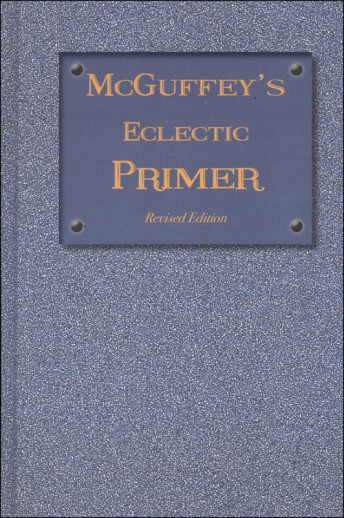We use cookies to make your experience better. To comply with the new e-Privacy directive, we need to ask for your consent to set the cookies. Learn more.
McGuffey's Eclectic Primer: Revised Edition (1879)
The Primer is designed for the beginning reader. Words are single-syllable and introduced in sound patterns; often 2-3 letter words at the beginning. Pictures are abundant; usually one per page. Stories are one to one and a half pages. Toward the end of the book, the words reflect a full range of phonics concepts, but still tend to be single-syllable. 64 pgs.
McGuffey's Eclectic Primer begins with the alphabet and moves quickly into short-vowel words such as cat and rat. By the second lesson, your child will be working with sentences such as "The cat has a rat" and "The rat ran at Ann." These evocative mini-stories build phonics and word-recognition skills, and encourage the child to want to learn. Most pages offer a vintage illustration that charmingly provides a clue as to the content of the lesson, and the original diacritical markings are included throughout.
Cursive is introduced by the fifth lesson, though it's just eight words and two short sentences. The complete cursive alphabet is included in the back as "Slate Exercises," but you will most likely want to supplement this instruction with a complete course in cursive. By the last lesson in the book, students are reading short stories and poems, many containing a lesson in virtue.
These readers defined our nation. The McGuffey Readers were originally published in 1836 and repeatedly "tweaked," ultimately differing somewhat from the very first version. This Revised Edition, published in 1879, culminated the "tweaks" and was still being used in American classrooms over fifty years later. Representing a universal quality of education that just might surpass our current day, McGuffey's provided a complete reading and language arts program in the capable hands of "schoolmarms" across the country. I suspect the impact on moral and historical education was significant as well. Now, in a complete facsimile (exact reproduction) edition, these hardback readers have all the vintage charm of their hundred-and-fifty-year-old counterparts.
The phonic method; the word method; the alphabet method. All three are ways of teaching reading and all are acknowledged by the Primer and First Reader. Those books are designed to facilitate any (or any combination) of these methods. New words are introduced at the beginning of each reading selection. Diacritical marks are used throughout the series to aid in pronunciation. There are drills in articulation (accurate pronunciation) and emphasis (elocution). Vocabulary and spelling can be taught in context; reading selections grow in length and complexity with the vocabulary and comprehension development. An interesting aspect of this edition is the presence of penmanship instruction and practice. Periodic selections are printed in a very legible and minimally embellished, no slant script. These segments encourage the skill of reading script as well as provide copywork passages. A complete script alphabet is provided in the Primer.
The stories, poetry, and artwork are what set this series apart. Partly because of their sheer age, there is a quaintness to them, but there is also a very strong moral thread; often reflecting a stated biblical worldview. Children's commendable actions and attitudes are recognized and rewarded in the stories. Problematic responses? Not so much. As the series matures and there are more contributions from outside authors, the content also broadens to include historical vignettes, literature, and poetry. But still, the moral thread remains. The artwork is truly charming – and often provides discussion possibilities. Mostly vintage engravings, there is, of course, many more in the younger levels.
Even though there are vast possibilities and resources here for reading and language arts programs, don't assume that it is open-and-go. You will need to take the content and massage it into daily lessons. But, if you'd like to have your children experience a simpler time and moral content, these readers are worth the effort. ~ Janice
| Product Format: | Hardcover |
|---|---|
| Brand: | Everyday Education |
| Grades: | PK-1 |
| ISBN: | 9781613220580 |
| Length in Inches: | 9.25 |
| Width in Inches: | 6.25 |
| Height in Inches: | 0.4375 |
| Weight in Pounds: | 0.55 |

